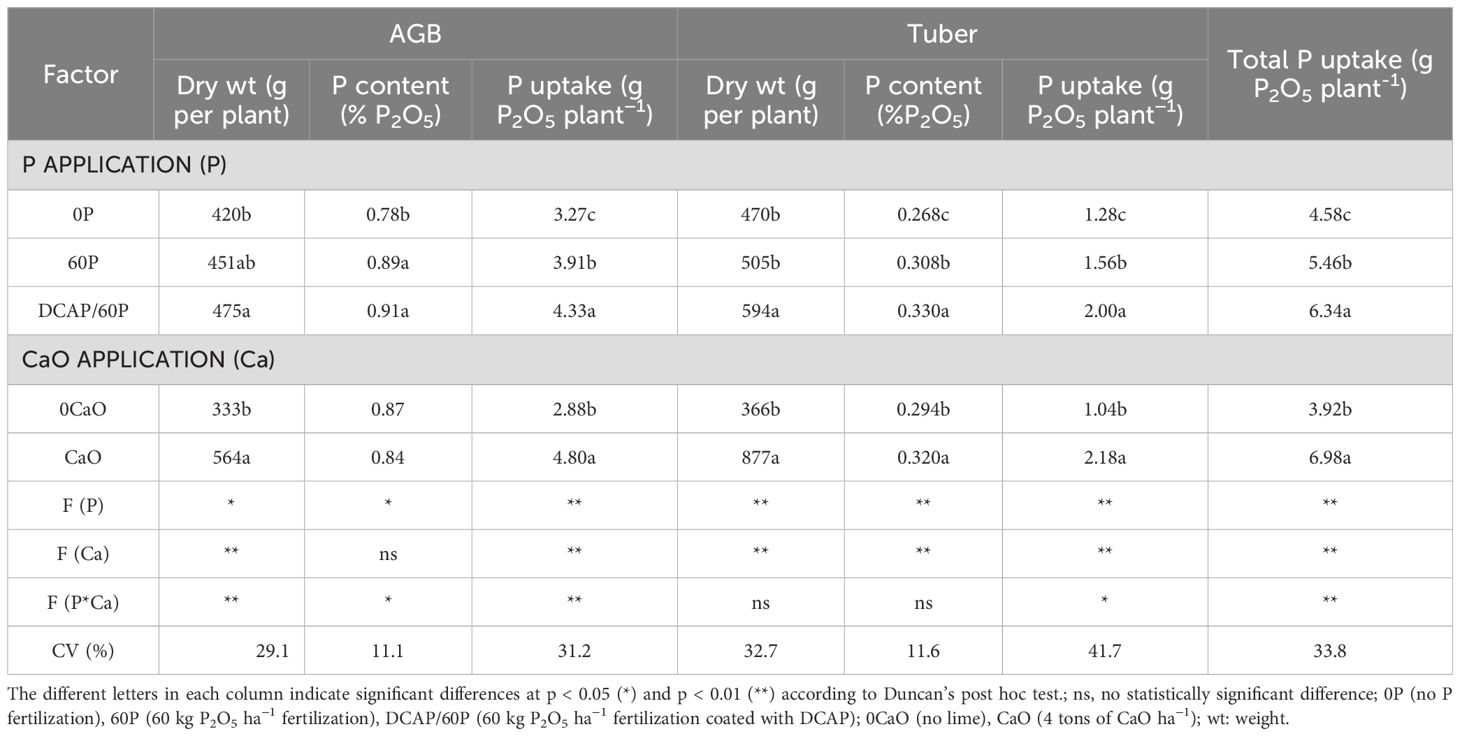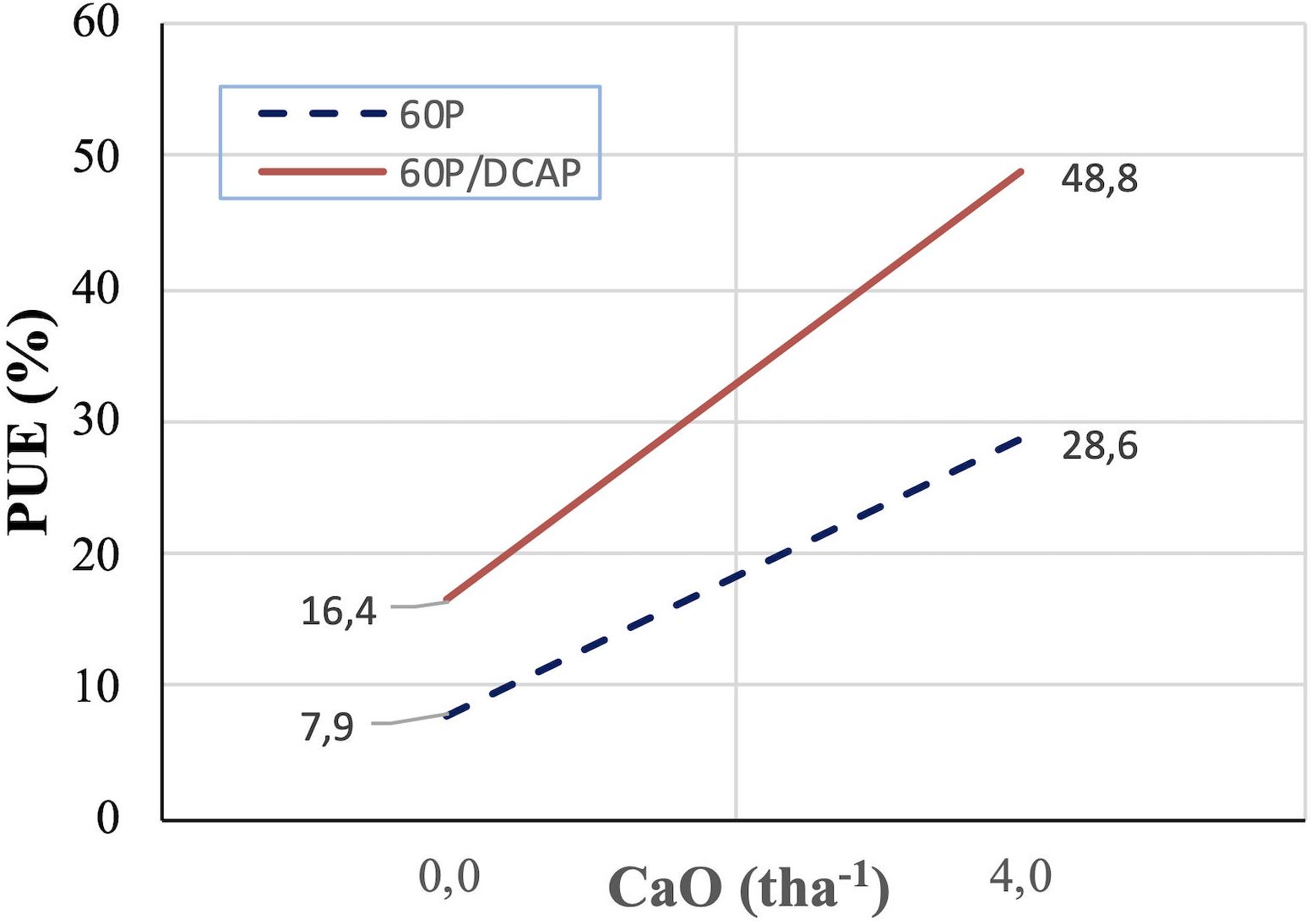- 1Faculty of Agriculture and Fishery, University of Cuu Long, Vinh Long, Vietnam
- 2College of Agriculture, Can Tho University, Can Tho, Vietnam
Introduction: Studies have reported that Dicarboxylic acid polymer (DCAP) -coated phosphorus fertilizer (DCAP/P) positively impacts crop growth and yield. However, studies on the effects of interaction between DCAP/P and CaO to improve the PUE of plants on acidic soils are limited.
Methods: This study aimed to (i) examine the effects of lime and DCAP on improving P uptake and cassava growth on acid sulfate soil and (ii) evaluate the effects of interaction between lime and DCAP/P on cassava PUE. The experiment was conducted in the greenhouse of the School of Agriculture, Can Tho University, from December 2022 to August 2023. The pot experiment was arranged in a completely randomized split-plot design, with factor A comprising two liming doses (0 and 4 t CaO ha-1) and factor B comprising three phosphorus (P) fertilization treatments (0P, 60P, and DCAP/60P), each with four replications. The local cassava variety ‘O Ta Bang’ was use inthe experiment.
Result: Our results showed that the total P uptake (g P2O5 plant-1) at 0Pand 60P only reached 72 and 96%, respectively, compared with the total P uptake of DCAP/60P. Among the CaO-treated samples, 60P treatment increased the plant PUE to 28.6%, while DCAP/60P treatment significantly increased the PUE to 48.8%.
Discussion: The interaction between DCAP/60P and CaO synergistically enhanced PUE more efficiently than between 60P and CaO.
1 Introduction
Cassava (Manihot esculenta Crantz) is a commercially important crop globally used as animal feed, biofuel source, and industrial raw material (Nweke et al., 2002). Cassava is a globally significant crop, with global output in 2021 reaching 315 million tons, covering 29.7 million hectares. In Vietnam, the cassava growing area is 532,600 hectares, with a yield of 10.27 million tons, ranking 7th in cassava production in the world (Otekunrin, 2024). Cassava is generally considered tolerant of low soil fertility (Howeler, 2002). However, high levels of undesirable elements in the soil can reduce cassava yield (Cassman et al., 2002; Ezui et al., 2016). In the Mekong Delta, acid sulfate soils (ASS) cover 1.6 million hectares, accounting for 40% of the natural land area. Cultivation on acid sulfate soils often encounters unfavorable soil factors such as low pH, high Fe2+, Al3+ content, which hinders root development, creates uneven nutrient content, especially phosphorus deficiency, and leads to reduced productivity (Xuan and Matsui, 1998; Dent, 1986; Iuliano et al., 2007). In plants, P is an important macronutrient involved in key physiological processes. Thus, limiting P supply from the soil limits crop growth and yield (Noor et al., 2017; Yaseen et al., 2017). However, P is one of the most difficult nutrients to absorb from the acidic soil (Aliyu et al., 2019). Experiments on omission of N, P, K on cassava in 04 growing areas on acid sulfate soil in the Mekong Delta showed that cassava yield responded poorly to phosphate fertilizer (Dang et al., 2016). Several previous studies have demonstrated the beneficial effects of calcium (Ca) in ameliorating Al toxicity in acidic soils (Hossain et al., 2014). Furthermore, the use of dicarboxylic acid polymers (DCAP) has been shown to prevent Fe and Al cations from precipitating P, therefore, this ACDP is expected to improve phosphorus use efficiency (PUE) for crops grown on acidic soils (Hopkins, 2015). However, there has been no evaluation of the effectiveness of combined liming and DCAP on acid sulfate soils used for cassava cultivation in the Mekong Delta. The objective of this study was to evaluate the combined use of lime and DCAP on PUE of cassava grown on acid sulfate soil.
2 Materials and methods
2.1 Greenhouse experiment and soil collecting
The study was conducted in the greenhouse of the School of Agriculture, Can Tho University, from December 2022 to August 2023. Table 1 illustrates the 3-year average (2021-2023) of climate conditions in Can Tho City, which has a tropical monsoon climate, divided into two distinct seasons. The rainy season lasts from May to November, the dry season from December to April of the following year. The average annual temperature is about 26.9°C, the average rainfall is 138.9 mm/year, highest in September (251.4 mm). The average number of sunshine hours per year is about 210.7 hours. The average humidity in the year is 83.3%.
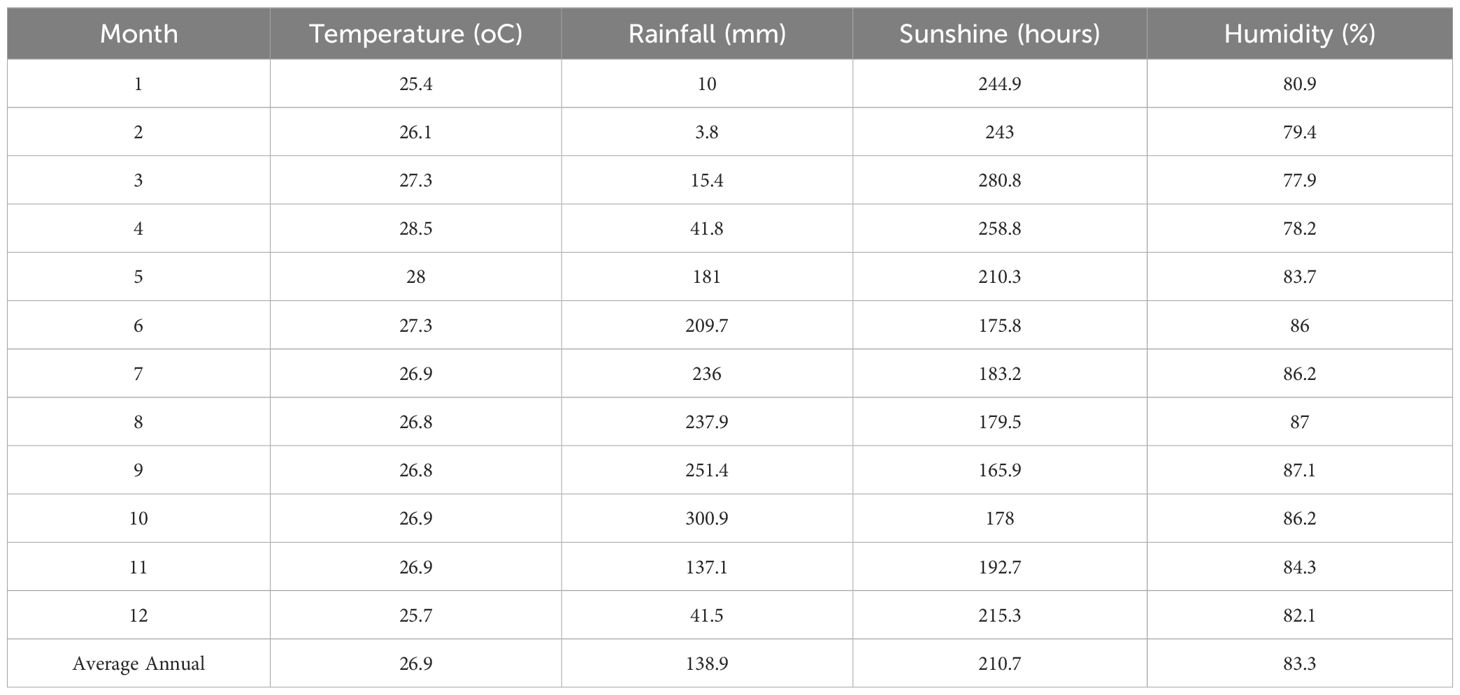
Table 1. The 3-year average (2021-2023) of climate and weather conditions during the experimental period in Can Tho city.
The soil was collected from the Binh Tan district (10°09′49.2″ N 105°45′47.7″ E), Vinh Long province, and classified as OrthiThionic-Gleysols according to the World Reference Base for Soil Resources (WRB) (2015). The soil was collected at the 0–20 cm layer for the pot experiment. After collection, the soil samples were dried and mixed well. Then, 10 kg of soil was put in each pot (26 cm × 12 cm/12L).
During the pot experiment, the pots were kept open, and plant growth was related to the surrounding climate. Every two days, tap water was added to the pot to maintain field capacity. When weeds are found growing in the pot, they are hand-pulled to remove the entire plant, including roots, from the soil. In the experiment, the dolomite powder, also called dolomitic lime, was prepared by heating dolomite rock. The MgO and CaO contents were 21% and 30%, respectively (Chau, 2024).
DCAP active ingredient is provided by Binh Dien fertilizer company (https://binhdien.com/) for testing the effectiveness of phosphate fertilizer on acid sulfate soil in the Mekong Delta. We coated 2 L of DCAP, also known as AVAIL polymer, with 1 ton of diammonium phosphate (DAP) fertilizer as previously recommended (Mooso et al., 2013).
2.2 Basis for lime application rate
A previous study on liming cassava on ASS in Binh Tan, Vinh Long, tested the effects of 2 and, 4t CaO ha−1, achieving cassava tuber yields of 23.8 and 29.6, respectively (Dang et al., 2016). Thus, the tuber yield obtained from 4 t CaO ha−1 was significantly higher than that obtained from 2 t CaO ha−1. Therefore, we used 4.0 t CaO ha−1 for the present study.
2.3 Experimental design
The pot experiment was arranged in a completely randomized split-plot design, wherein factor A comprised two liming doses (0 and 4 t CaO ha−1) and B comprised three P fertilization treatments (0P, 60P, and DCAP/60P), with four replications (each replication was one pot). Thus, there were 24 pots in total (Figure 1).
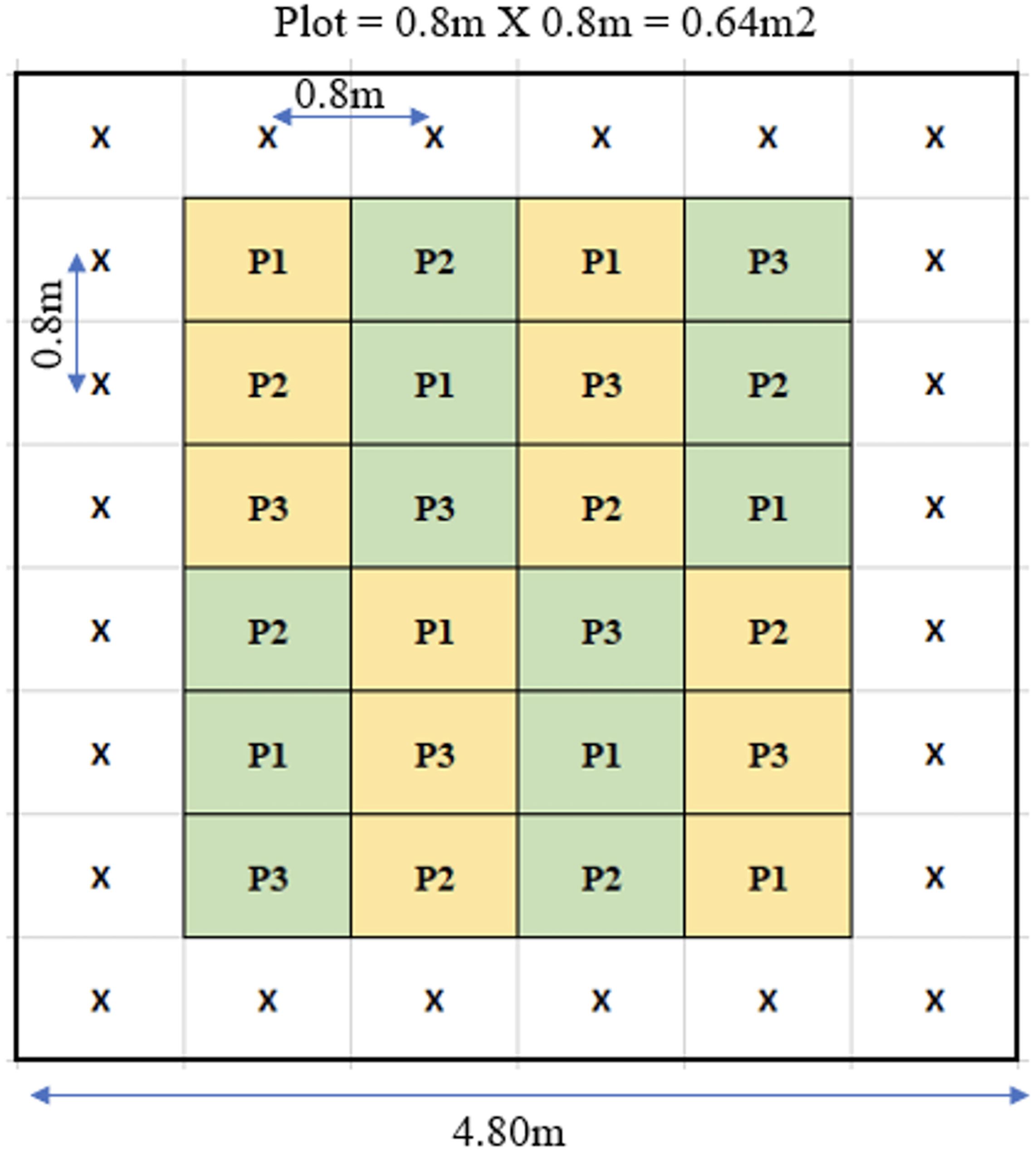
Figure 1. The experiment was arranged in a split-plot design: (i) Factor A with two liming doses of 0 t CaO ha−1(yellow color) and 4 t CaO ha−1 (green color), and (ii) factor B with three P applications of 0P (P1), 60P (P2), and DCAP/60P (P3).
We used a local cassava variety, ‘O Ta Bang’, which has a growing period of 8 months. Hardwood cuttings were taken from cassava plants that are more than six months old. Although cassava is a perennial crop, optimum tubers harvesting depends on the variety and growing conditions. For instance, the tubers can be harvested in humid tropical regions after 6–7 months (El-Sharkawy and Cock, 1990). To grow cassava in the pot experiment, the entire stake, comprising 20 cm long stem cuttings, was placed horizontally and buried to a depth of 10 cm.
The fertilizers used included DAP (comprising 18% nitrogen (N) and 46% P2O5) and KCl (containing 60% K2O). Each pot was fertilized with an amount of fertilizer equivalent to 90N-60P2O-90K2O. Fertilization time and dosage were as follows: The entire lime was used as basal fertilizer, and 50% N + 50% P2O5 + 50% K2O were applied after 25 and 55 days of sowing (Department of Cultivation and Plant Protection, Ho Chi Minh City, 2024).
2.4 Soil sampling and analysis
Soil was collected at the 0–20 cm layer, dried, mixed well, and cleared of trash. The physical and chemical properties of the soil were then analyzed at the soil laboratory of the School of Agriculture, Can Tho University.
The soil surface (0.20cm) was a silty clay soil with a pH of 3.63 (1:1 soil and water suspension), containing 78 g organic matter/kg dry soil (Walkley-Black), 12.8 mg available P/kg dry soil (Bray-2 extraction), 14.9 meq H+ 100g-1 (H++ Al3+ - potential acidity extracted with Ca acetate buffered at pH 7), 12.6 Exch. Al3+, 71.0% Al saturation and the following exchangeable cations extracted by BaCl2 (cmol kg-1) including K+, Na+, Ca2+ and Mg2+ (spectrophotometer U-1100, Hitachi Co. Ltd., Japan) are: 0.28, 1.70, 2.16 and 1.04, respectively. Al saturation (Al3+ sat.) was calculated as the ratio of exchangeable Al to the sum of exchangeable Al, Ca, Mg, K, and Na. Soil texture (Pipette Method) of topsoil with the average values of clay, silt, and sand in the top soil were 44.3%, 38.6% and 0.6%, respectively.
Leaf and stem tissues of cassava plants were sampled. After determining their fresh weight, the samples were washed and dried in the sun, transferred to a drying oven, and dried at 70 degrees Celsius until the weight was constant. Then, the samples were weighed to determine their dry weights. The dried samples were crushed with a plant sample grinder to determine the total P content.
2.5 Growth, yield component, and productivity of cassava
Aboveground biomass (AGB) of a plant is the total biomass of organic matter above ground, including stems, leaves, flowers, and fruits. AGB sampling involves separating and evaluating individual parts, drying the removed material, and weighing its mass. AGB is an important index for monitoring plant growth (Poorter and Nagel, 2000).
Furthermore, from above ground, the cassava stem is divided into three parts: Hardwood (0–0.75 m), semi-hardwood (0.75–1.5 m), and shoot tip (>1.5m) (Chiona et al., 2016).
In this study, growth parameters measured at harvest included plant height, number of leaves, leaf size (leaf length and width), weight of AGB (cumulative weight of leaves and stems), and stem diameters (hardwood, semi-hardwood, and shoot tip).
Yield and yield component parameters of cassava tubers included number of tubers, tuber length and width, average tuber weight, and cassava stem and leaf biomass.
2.6 Statistical analysis
SPSS software (version 20.0) was used for data analysis. Variance analysis was used to compare the differences between means among the treatments using the Duncan’s test with significance levels at 5% and 1%. The relationships between the dry weight and P content and uptake of cassava plant parts were determined by Pearson’s correlation coefficient.
2.7 PUE
PUE was calculated using the formula proposed by Shabnam and Iqbal (2016):
Where ∑ P upt = Total P uptake (mgkg-1).
3 Results
3.1 Effects of P and lime fertilization on changes in soil properties
Soil pH value <5.0 (Table 2). Among the P fertilized samples, the soil pH was comparable across 0P (4.12), 60P (4.09), and DCAP/60P (4.03) samples. Similarly, the three groups exhibited only mild differences in the EC, potential acidity, and levels of Ca2+, Mg2+, Na+, K+, and Al3+ (Table 2).
In contrast, at 30 and 60 days after treatment (DAT), the available P levels in DCAP/60P soil were significantly higher (22.0 and 17.4 ppm, respectively) than those in 0P soil (17.5 and 13.4, respectively).
Furthermore, the CaO-treated soil exhibited significantly higher pH, EC, and Ca2+ and Mg2+ levels (4.54, 0.63, 10.9, and 1.31, respectively) than the CaO-untreated soil (3.61, 0.55, 1.83, and 1.08, respectively) (Table 2). However, the CaO-treated soil exhibited a lower potential acidity and Al3+ sat. (6.01 and 29.8, respectively) than the CaO-untreated soil (14.9 and 72.6, respectively). In addition, at 30 and 60 DAT, Ca-treated oil exhibited significantly higher soil P availability (24.0 and 18.3 ppmP, respectively) than CaO-untreated soil (14.8 and 14.9 ppmP, respectively).
3.2 Effects of P application and lime on growth, yield, and P uptake
3.2.1 Cassava growth
The 60P and DCAP/60P groups exhibited significantly higher values of plant height, number of leaves, leaf size, and stem diameter than the 0P group, with more prominent effects observed for the DCAP/60P group (Table 3). Typically, among the values of plant height, the 0P had lowest values of plant height (188) compared to 60P (210) and DCAP/60P (277). Similarly, liming enhanced plant height, number of leaves, leaf size, and stem diameter of cassava. Typically for such comparisons the number of leaves in CaO (118) was significantly higher than that of 0CaO (96) (Table 3).
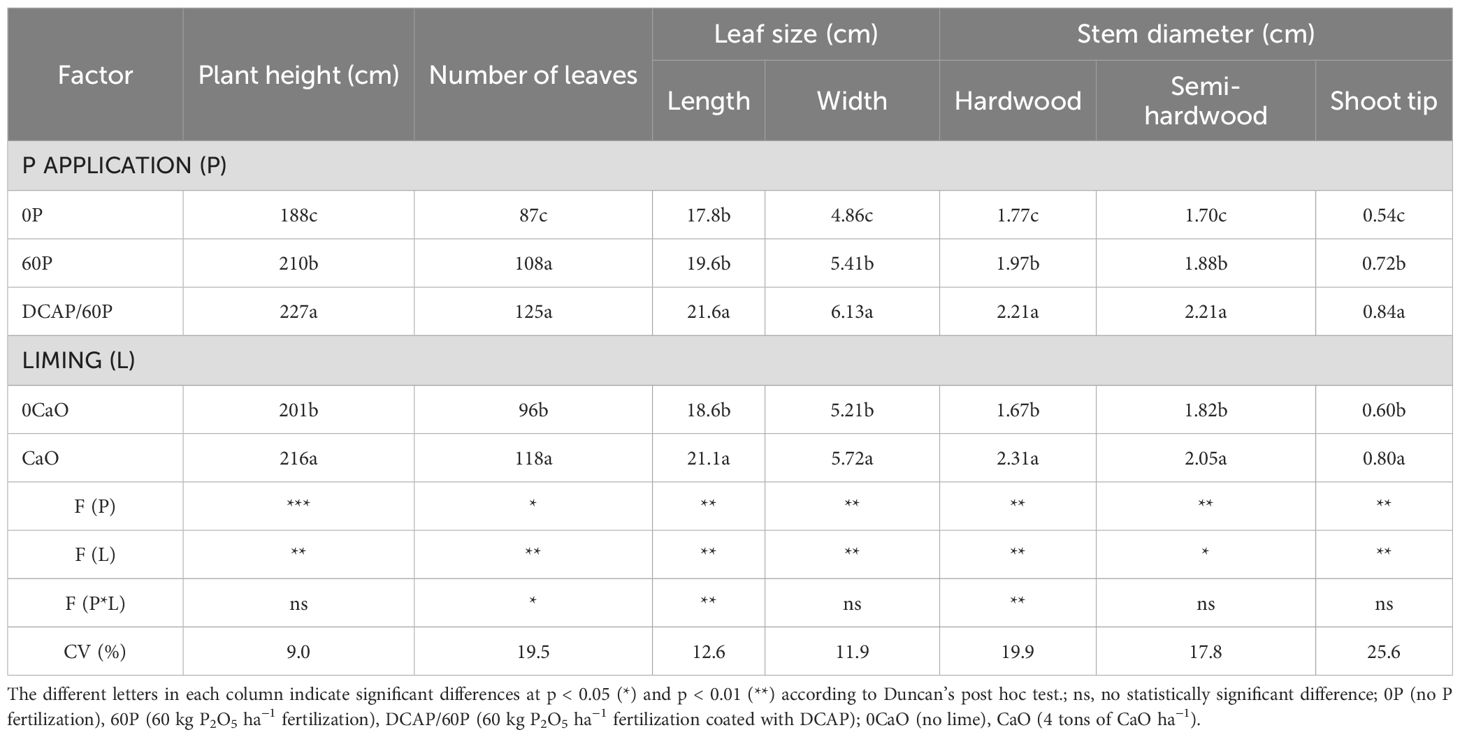
Table 3. Effects of DCAP-coated phosphate fertilizer and liming on the growth of cassava at harvest.
Linear regression correlations between leaf number and AGB weight revealed R2 = 0.77 (Figure 2A), and correlation between hardwood diameter and AGB weight has R2 = 0.75 (Figure 2B).
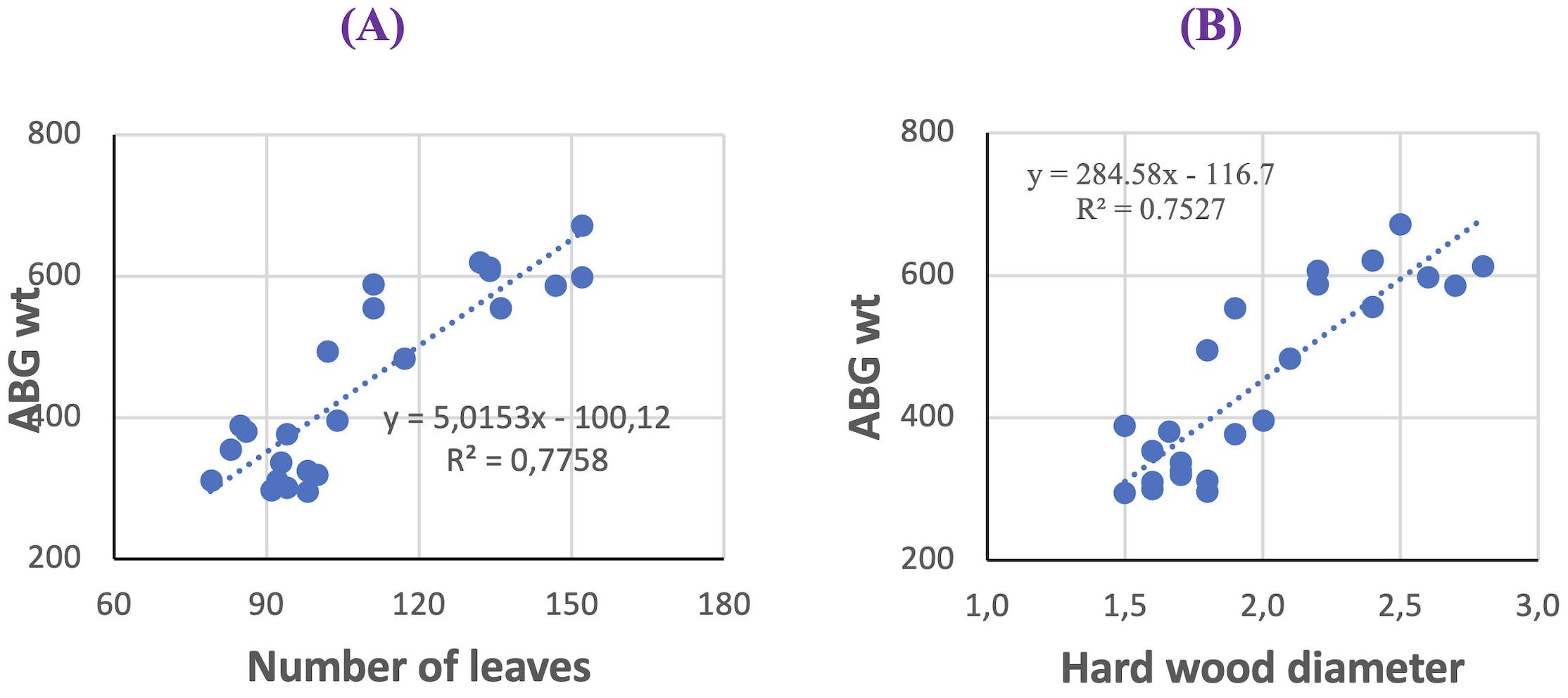
Figure 2. Effects of (A) leaf number and (B) hardwood diameter on the AGB weight of cassava grown in ASS. Greenhouse experiment at School of Agriculture, Can Tho University. August 2023.
3.2.2 Yield and P uptake
Among the P-treated plants, the 60P group exhibited significantly higher dry weight (g per plant), P content (% P2O5), and P uptake (g P2O5 plant−1) of the AGB (451, 0.89, and 3.91, respectively) than the 0P group (420, 0.78, and 3.27, respectively) (Table 4). Similarly, the 60P group exhibited significantly higher biomass (g per plant), P content (% P2O5), and P uptake (g P2O5 plant−1) of the tuber (505, 0.308, and 1.56, respectively) than the 0P group (470, 0.268, and 1.28, respectively). In addition, among all P-treated groups, the DCAP/60P group exhibited the highest total P uptake (6.34 g P2O5 plant−1) with the highest P uptake in both AGB (4.33 g P2O5 plant−1) and tubers (2 g P2O5 plant−1).
P application in 60P and DCAP/60P groups resulted in higher plant height, number of leaves, leaf size, and stem diameter compared to the 0P group. Similarly, CaO treatment also enhanced the growth parameters of cassava (Table 3). As shown in Table 4, the dry weights of AGB and tuber of the 60P and DCAP/60P groups were higher than those of the 0P group. Similarly,
Furthermore, the CaO-treated plants exhibited significantly higher dry weights (g per plant) of AGB and tuber and total P uptake (564, 877, and 698 g P2O5 plant−1, respectively) than CaO-untreated plants (333, 366, and 3.92 g P2O5 plant−1, respectively) (Table 4).
The interaction between P and CaO application have been recorded on AGB dry weight, AGB P uptake, tuber dry weight, tube P uptake and P uptake. As a result, the interaction between P and CaO application affected the total P uptake (Table 4).
3.3 Effects of the interaction between DCAP and CaO on PUE
We observed that in the 60P and DCAP/60P groups, the CaO-treated plants exhibited substantially higher PUE (28.6% and 48.8%, respectively) than the CaO-untreated plants (7.9% and 16.4%, respectively) (Figure 3).
Among the groups treated with 4 tons of CaO ha−1, the 60P plants exhibited substantially smaller tubers than the DCAP/60P plants (Figure 4).
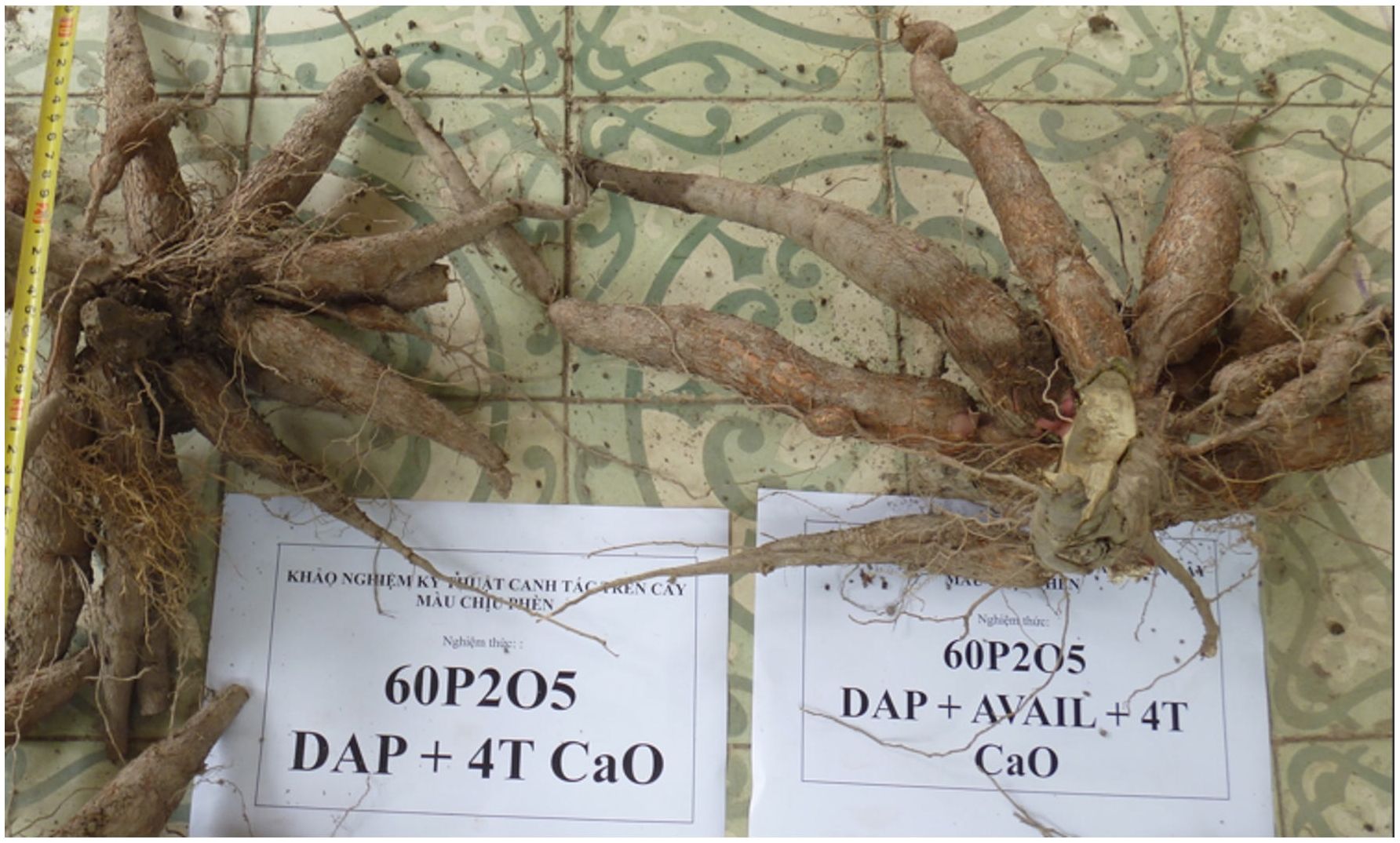
Figure 4. Under the same CaO application (4.0 t ha−1), the tuber size of the 60P-treated plants was substantially smaller than that in the DCAP/60P (AVAIL)-treated plants.
3.4 Correlation among agronomic parameters and soil chemical properties
Figure 5 shows the correlation matrix among agronomic parameters, cassava P uptake, and soil properties. AGB dry weight positively correlated with AGB P uptake, tuber P uptake, soil exch. Ca2+, and soil exch. Mg2+ (r = 0.93, 0.87, 0.87, and 0.51, respectively). However, AGB dry weight negatively correlated with soil potential acidity and soil exch. Al3+ (r = −0.92 and −0.88, respectively). Similarly, the tuber dry weight positively correlated with AGB P uptake, tuber P uptake, soil exch. Ca2+, and soil exch. Mg2+ (r = 0.92, 0.87, 0.87, and 0.51, respectively). However, tuber dry weight negatively correlated with potential soil acidity and soil exch. Al3+ (r = −0.89 and −0.94, respectively).
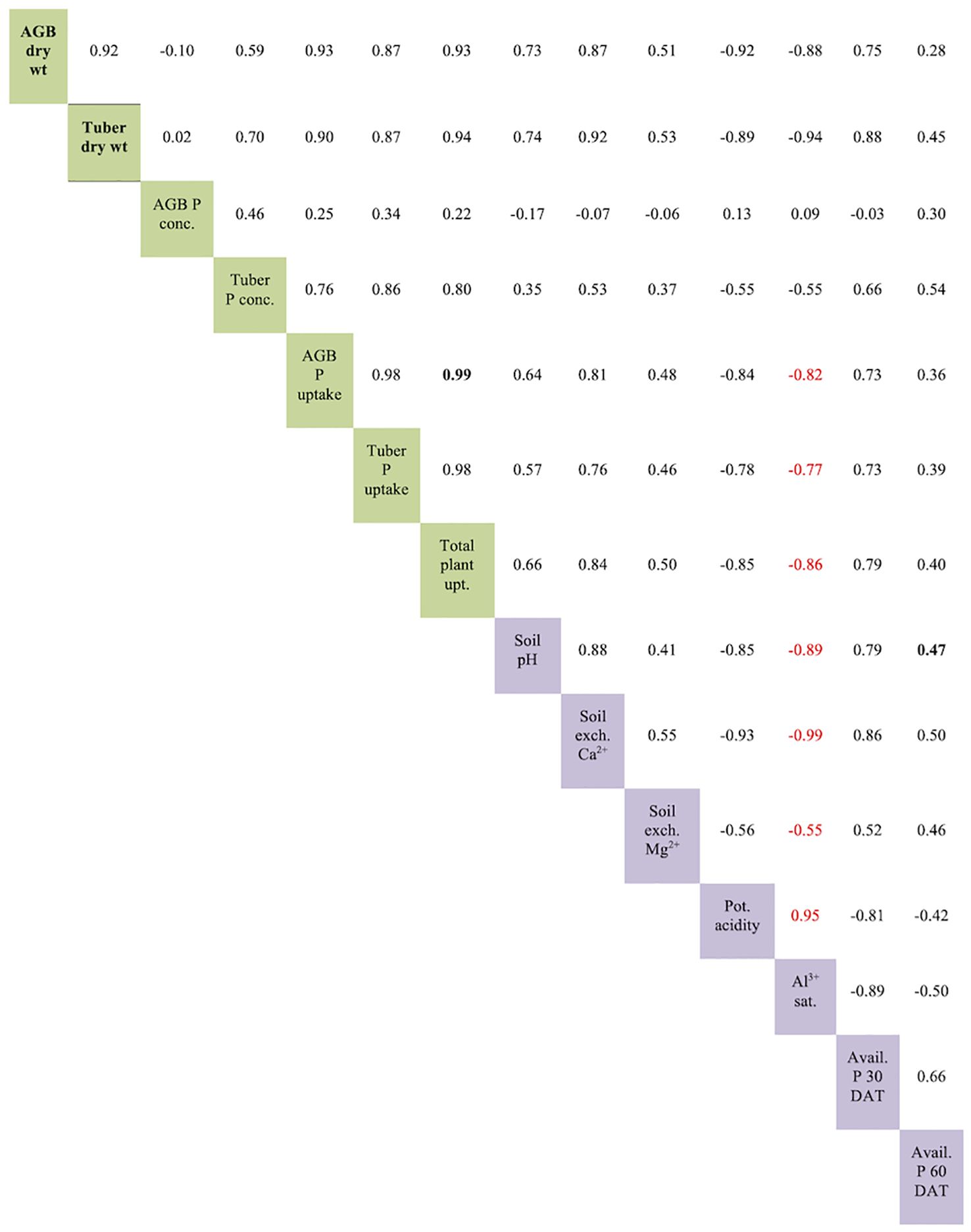
Figure 5. Correlation matrix among the dry weights and P content and uptake of cassava plant parts and soil chemical properties.
The AGB P levels are derived from the soil. However, the AGB P levels only mildly correlated with soil available P content at 30 and 60 DAT (r = −0.03 and 0.30, respectively). Similarly, AGB P levels only mildly correlated with soil exch. Ca2+, soil exch. Mg2+, potential soil acidity, and soil Al3+ sat. (r = −0.07, −0.06, 0.13, and −0.09, respectively) (Figure 5).
The available P content at 30 DAT strongly correlated with almost all agronomic parameters and soil indicators except potential acidity and Al3+ sat. However, the available P content at 60 DAT only moderately correlated with agronomic parameters and soil indexes, with r values ranging from 0.3 to 0.4.
4 Discussion
4.1 Effects of P and CaO application on soil acidity
The pH value of the soil was <5.0 (Table 2) because pyrite material in the soil profile appeared at a depth of more than 50 cm (Khoa et al., 2023; Ngoc et al., 2023), and under oxidized conditions when the soil became aerated, acidity occurred due to pyrite oxidation.
Although cassava is mostly grown on acidic soils, the pH is seldom low enough or the Al sat. is seldom high enough to warrant lime applications. In the CaO-untreated group (Table 2), the soil pH was very low (3.61) owing to the high potential acidity associated with Al sat. Then, Al can be toxic to the plant. Low pH causes a dissolution of minerals such as Al, Mn, and Fe (Rahman et al., 2018). Moreover, since the exchangeable base cations (Ca2+, Mg2+, and K+) of the soil are replaced by H+ and Al3+, the CaO-untreated group exhibited lower Ca2+ and Mg2+ levels (1.83 and 1.08, respectively) than the CaO-treated group (10.09 and 1.31, respectively). Application of 0P, 60P and DCAP/60P did not affect soil EC. According to Howeler and Aye (2014), cassava tuber yield is affected when soil EC rises above 0.5–0.7 mmhos/cm.
Al toxicity is considered toxic to plant growth on acidic soils (Kochian et al., 2005). When the pH is ≤4.5, the Al3+ species predominates in the soil, promoting complete desorption and leaching of the alkaline exchangeable cations (Garzón et al., 2011). Exchangeable Al is the major reservoir of labile Al and can rapidly enter the soil solution through exchange with other cations. Therefore, Al sat. is a reliable measure of the potential Al toxicity in acidic soils (Kariuki et al., 2007). As shown in Table 2, the maximum Al sat. reached 72.6% in CaO-untreated soil. Notably, cassava can tolerate an Al sat. of 60% to 80%.
Many crops grow best when the soil pH is between 6.0 and 7.0 because this pH range facilitates the availability of all essential nutrients (Rosen and Bierman, 2005). Typically, a lime requirement test is used to determine the amount of lime required to achieve the target pH (Mosharrof et al., 2021). Based on the optimum tuber yield received in previous field experiments, the current study focused on the CaO concentration of 4 t ha−1 for the greenhouse experiments (Dang et al., 2023). In the south of Peninsular Malaysia, a highly significant response to the application of 3 t lime ha−1 has also been indicated (Howeler, 2014).
Liming acidic soils is the most effective way to reduce the available Al content in soils. Applying appropriate amounts of lime to acidic soils induces several beneficial changes in the soil characteristics. For instance, it improves aggregate stability (Bolan et al., 2003) and the bioavailability of P, Ca, Mg, and molybdenum (Mo) (Kariuki et al., 2007). CaO application (Table 2) to the soil simultaneously reduced its potential acidity and Al sat. Moreover, levels of exchangeable Ca2+ and Mg2+ increased in the current study because of dolomite (CaMg(CO3)2) use. Thus, the CaO application improved soil Ca2+ and Mg2+ levels (10.9 and 1.31, respectively). Howeler (1996a, b) indicated that cassava can grow well on soils with average exchangeable Ca2+ and Mg2+ values of 1–5 and 0.4–1, respectively. The CaO treatment in the current study resulted in significantly higher Ca2+ and Mg2+ levels (10.9 and 1.31, respectively) compared to those in the CaO-untreated soil (1.83 and 1.08, respectively) (Table 2).
Moreover, the soil Al3+ sat. is reduced by liming. At soil pH > 5.5, Al sat. becomes zero, and Al toxicity is not a problem anymore (Howeler, 1991). However, at pH < 5.5, Al sat. increases. The critical Al3+ sat. level for cassava is 80% (CIAT, 1979; Howeler, 1980).
4.2 P availability
Although cassava has a long growing period of 8 months, several studies have used two split fertilizer applications at one month and two months after planting (Hauser et al., 2014; Katuromunda, 2021; Macalou et al., 2018). Table 2 shows the P availability in CaO-untreated soil at 30 DAT (13.9 and 14.9 ppm P, respectively). Howeler and Aye (2014) found that available P levels (4–10 ppm; Bray II) to cassava are much lower than those available to most other crops (10–18 ppm). This finding suggested that cassava will grow well in soils with low P levels compared to other crops, which eventually become P-deficient. Among the five rates of P tested, cassava varieties growing in semi-arid regions had a significantly higher PUE at 60 kg P2O5 ha−1.
Adsorption and desorption of P from solid soil phases and its conversion to ions (liquid phase) are important reactions of P in soils (Ghodszad et al., 2022), especially in ASSs. The adsorption of the cations present in lime materials (Ca2+ and Mg2+) into soil colloids reduces P adsorption in soils (Eslamian et al., 2021). Soil adsorption limits P availability, while desorption makes P available to the plants. However, P is easily leached from the soil. Studying P adsorption and desorption in soil is essential to ensure efficient P utilization by crops (Yang et al., 2019).
4.3 Effects of P and CaO application on the growth and P uptake of cassava
Usually, the roots develop to form a fibrous root system. A few of the fibrous roots develop to become storage roots. However, the absorption of water and nutrients is primarily mediated by the fibrous roots rather than the storage roots (El-Sharkawy and Cock, 1990).
The CaO-treated plants exhibited significantly higher dry weights of AGB and tuber than the CaO-untreated plants. These findings showed that P application positively impacted the growth (Table 3) and biomass of cassava plants (Table 4). According to Kumar et al. (2019), P is an indispensable component of important compounds in plant cells, such as phosphate sugars, photosynthetic intermediates, and phospholipids that make up the plant biomass. This result was consistent with the findings of Opala (2011), who reported that basal application of lime and P significantly increased the dry biomass.
The correlations observed between AGB dry weight and leaf number (r2 = 0.73) and AGB dry weight and hardwood diameter (r2 = 0.75) (Figures 1A, B, respectively) were consistent with those observed by Menegucci et al. (2023), indicating that the total dry matter in cassava positively correlated with its growth parameters.
The DCAP/60P group exhibited significantly higher tuber dry weight than the 60P group (594 vs. 505 g plant−1) (Table 4). P fertilization with DCAP supplementation most optimally increases PUE by reducing P ion release in the soil solution and preventing P from being immobilized by heavy metals (Imran et al., 2018).
The effects of P–CaO interactions on AGB and tuber dry weight were related to soil liming, which may have increased organic P mineralization (Table 4). Previous studies (Cock and Connor, 2020; Njoku and Enwezor, 1991) have suggested that cassava is tolerant to soil acidity. However, P fertilization can increase cassava yield (22% or 4.7 t ha−1) (Rosa et al., 2021). Liming-induced improvement of P availability in acidic soils is primarily attributed to improved soil acidity, reduced Al toxicity, and the availability of Ca and Mg in the lime compounds (Soratto et al., 2019; Fageria and Barbosa Filho, 2008).
4.4 P uptake and PUE
In the present study, AGB had significantly higher P uptake capacity (g P2O5 plant−1) in CaO-treated samples (4.80) than in CaO-untreated samples (2.88). Similar results were observed in tubers, which showed significantly higher P uptake in CaO-treated samples (2.18) than in CaO-untreated samples (1.04) (Table 4). It is considered that the high Fe and Al contents in the acidic soil immobilize soil P, making it unavailable to the plants (Fageria, 2009). Therefore, the CaO-untreated 60P and DCAP/60P plants exhibited lower PUEs (7.9 and 16.4, respectively) than their CaO-treated counterparts (16.4 and 46.8, respectively) (Figure 3). According to Baggie (2002), under normal farming conditions, only 5–25% of the fertilized P is useful for plants, while 75–95% of the P is in a form that is difficult for plants to absorb (Mortvedt, 1994). Therefore, on ASSs, the high Fe and Al levels are considered a limiting factor to crop productivity, which can be improved by using lime in combination with DCAP.
4.5 Correlation relationships
We observed a positive correlation (r = 0.92) between dry weights of AGB and tuber (Figure 5), which was consistent with previous studies on cassava (Alves et al., 2022). There was a strong positive correlation between total plant biomass and storage root biomass of cassava (r2 = 0.96), as was also shown by Boerboom (1978). The increase in tuber yield and AGB in cassava was found to be related to photosynthetic rate. El-Sharkawy and Cock (1990) also suggested that the photosynthetic assimilation demand of the tuber leads to increased photosynthetic activity.
However, we observed a poor correlation between AGB P levels and dry weight (r = −0.10). This phenomenon is called the dilution effect, which occurs when the accumulated dry weight of biomass increases faster than the amount of minerals accumulated in the plant (Jarrell and Beverly, 1981). Moreover, we also observed a poor correlation between AGB P levels and tuber dry weight (r = 0.02) since, at harvest time, dry matter mainly accumulates in the tuber, followed by stems and leaves (Howeler and Cadavid, 1983). Several previous studies have suggested that nutrient dilution is more severe in cassava than in other crops (Greenwood et al., 1990; Justes et al., 1994; Ciampitti et al., 2013). Cassava tubers are a good source of carbohydrates and exhibit poor nutrient accumulation (Burns et al., 2010).
The potential acidity is impacted by H+ and Al3+ ions, which are absorbed in the solid phase. Potential acidity refers to the buffering capacity of the soil. Therefore, potential acidity is associated with many constraints to cassava growth, as evidenced by the negative correlation of potential acidity with AGB dry weight, tuber dry weight, AGB P uptake, and tuber P uptake (r = −0.92, −0.89, −0.84, and −0.78, respectively) (Figure 5). Similarly, a negative correlation was also observed between potential acidity and available P levels at 30 and 60 DAT (r = −0.89 and −0.50, respectively). The soil Al3+ content also negatively correlated with available P content at 30 and 60 DAT.
To overcome Al phytotoxicity, lime material, primarily composed of Ca oxides and hydroxides, is commonly used in acidic soils (Mora et al., 2002). Ca plays an important role in improving soil pH and reducing Al3+ exchange in soil, improving physiological and biochemical processes in plants (Jing et al., 2024). We also observed that soil Ca2+ content positively correlated with AGB dry weight, tuber dry weight, and total plant P uptake (r = 0.87, 0.92, and 0.84, respectively). Similarly, soil Mg2+ content positively correlated with AGB dry weight, tuber dry weight, and total plant P uptake (r = 0.51, 0.53, and 0.50, respectively). This finding indicated the benefits of dolomite liming in improving cassava growth and neutralizing soil acidity.
When assessing the impact of ASSs on plant growth, special attention should be paid to soil acidity, which profoundly influences various factors other than P availability in the soil.
5 Conclusion
The combined use of lime and DCAP was successful in enhancing PUE of cassava grown on acid soils. This result is considered a promising cultural practice in improving cassava yield, grown on large areas of acid sulfate soils such as in MD.
Data availability statement
The raw data supporting the conclusions of this article will be made available by the authors, without undue reservation.
Author contributions
NQ: Methodology, Supervision, Writing – original draft, Writing – review & editing. NN: Conceptualization, Methodology, Resources, Writing – original draft. PT: Project administration, Resources, Writing – original draft. LL: Supervision, Writing – original draft.
Funding
The author(s) declare that no financial support was received for the research, authorship, and/or publication of this article.
Conflict of interest
The original contributions presented in the study are included in the article/Supplementary Material. Further inquiries can be directed to the corresponding author.
Generative AI statement
The author(s) declare that no Generative AI was used in the creation of this manuscript.
Publisher’s note
All claims expressed in this article are solely those of the authors and do not necessarily represent those of their affiliated organizations, or those of the publisher, the editors and the reviewers. Any product that may be evaluated in this article, or claim that may be made by its manufacturer, is not guaranteed or endorsed by the publisher.
References
Aliyu I. A., Yusuf A. A., Uyovbisere E. O., Masso C., and Sanders I. R. (2019). Effect of co-application of phosphorus fertilizer and in vitro-produced mycorrhizal fungal inoculants on yield and leaf nutrient concentration of cassava. PloS One 14, e0218969. doi: 10.1371/journal.pone.0218969
Alves F. A. T., Silveira F. P. M., Lopes W. A. R., Oliveira F. A., Silveira L. M., and Barros Júnior A. P. (2022). Accumulation and efficiency of phosphorus use in irrigated cassava cultivars in the Brazilian semiarid region. Rev. Bras. Eng. Agric. Ambient. 28, 930–938. doi: 10.1590/1807-1929/agriambi.v26n12p930-938
Baggie I. (2002) Effect of organic residue and inorganic fertiliser phosphorus on phosphorus transformation and utilisation by upland rice. PhD Thesis (UK: University of Reading).
Boerboom B. W. J. (1978). A model of dry matter distribution in cassava (Manihot esculenta Crantz). Neth. J. Agric. Sci. 26, 267–277. doi: 10.18174/njas.v26i3.17087
Bolan N. S., Adriano D. C., and Naidu R. (2003). Role of phosphorus in (im)mobilization and bioavailability of heavy metals in the soil-plant system. Rev. Environ. Contam. Toxicol. 177, 1–44. doi: 10.1007/0-387-21725-8_1
Burns A. E., Gleadow R. M., Cliff J., Zacarias A., and Cavagnaro T. R. (2010). Cassava: the drought, war and famine crop in a changing world. Sustainability 2, 3572–3607. doi: 10.3390/su2113572
Cassman K. G., Dobermann A., and Walters D. T. (2002). Agroecosystems, nitrogen-use efficiency, and nitrogen management. Ambio 31, 132–140. doi: 10.1579/0044-7447-31.2.132
Chau K. B. (2024). Dolomite powder. Available online at: https://khangbaochau.vn/bot-da/bot-da-dolomite/. (Accessed May 10, 2025).
Chiona M, Ntawuruhunga P, Mukuka I, Chalwe A, Phiri N, Chikoti P, et al. (2016). Growing Cassava: Training Manual for Extension and Farmers in Zambia. International Institute of Tropical Agriculture (IITA), Zambia
Ciampitti I. A., Camberato J. J., Murrell S. T., and Vyn T. J. (2013). Maize nutrient accumulation and partitioning in response to plant density and nitrogen rate: I. Macronutrients. Agron. J. 105, 783–795. doi: 10.2134/agronj2012.0467
CIAT (1979). Annual Report for 1978. Cali, Colombia: Inter-American Center of Tax Administrators, Cassava Program. Colombia: Centro Internacional de Agricultura Tropical 76–84.
Cock J. H. and Connor D. J. (2020). “Cassava,” in Crop physiology: case histories for major crops. Eds. Sadras V. O. and Calderini D. F. (Colombia: Academic Press), 589–633.
Dang L. V., Quyen N. K., Ve N. B., Toan L. P., Huu T. N, Hung N. N., et al. (2016). Effects of N, P, K fertilizers application on cassava growth and yield cultivated on acid sulphate soils in the Vietnamese Mekong Delta. Can Tho University Journal of Science. Special issue: Agriculture 4:29–37. doi: 10.22144/ctu.jsi.2016.100
Dang L. V., Hung N. N., Toan L. P., and Ngoc N. (2023). Influence of dicarboxylic acid polymer in enhancing the growth and productivity of sweet potato (Ipomoea batatas L.) in acidic soil. Plant Biology Peer J. doi: 10.7717/peerj.16178
Dent D. (1986). Acid Sulphate Soils: A Baseline for Research and Development (International Institute for Land Reclamation and Improvement/ILRI).
Department of Cultivation and Plant Protection, Ho Chi Minh City (2024). Procedure of Cultivating and Producing Clean Cassava Varieties. Available online at: https://chicucttbvtvhcmhttp://gov.vn/hoat-dong-don-vi/quy-trinh-canh-tac-va-san-xuat-giong-khoai-mi-sach-benh-kham-la-o-ho-nong-dan-1377.html.
El-Sharkawy M. A. and Cock J. H. (1990). Photosynthesis of cassava (Manihot esculenta). Experimental. Ex. Agric. 26, 325–340. doi: 10.1017/S0014479700018494
Eslamian F., Qi Z., and Qian C. (2021). Lime amendments to enhance soil phosphorus adsorption capacity and to reduce phosphate desorption. Water Air Soil pollut. 232, 66. doi: 10.1007/s11270-021-05024-3
Ezui K. S., Franke A. C., Mando A., Ahiabor B. D. K., Tetteh F. M., Sogbedji J., et al. (2016). Fertiliser requirements for balanced nutrition of cassava across eight locations in West Africa. Field Crops Res. 185, 69–78. doi: 10.1016/j.fcr.2015.10.005
Fageria N. K. and Barbosa Filho M. P. (2008). Influence of pH on productivity, nutrient use efficiency by dry bean, and soil phosphorus availability in a no‐tillage system. Communications in Soil Science and Plant Analysis, 39, 1016–1025.
Garzón E., González-Andrés F., García-Martínez V. M., and de Paz J. M. (2011). Mineralization and nutrient release of an organic fertilizer made by flour, meat, and crop residues in two vineyard soils with different pH levels. Commun. Soil Sci. Plant Anal. 42, 1485–1496. doi: 10.1080/00103624.2011.581719
Ghodszad L., Reyhanitabar A., Oustan S., and Alidokht L. (2022). Phosphorus sorption and desorption characteristics of soils as affected by biochar. Soil Till. Res. 216, 105251. doi: 10.1016/j.still.2021.105251
Greenwood D. J., Lemaire G., Gosse G., Cruz P., Draycott A., and Neeteson J. J. (1990). Decline in percentage N of C3 and C4 crops with increasing plant mass. Ann. Bot. 66, 425–436. doi: 10.1093/oxfordjournals.aob.a088044
Hauser S., Wairegi L., Asadu C. L. A., Asawalam D. O., Jokthan G., and Ugbe U. (2014). Cassava system cropping guide (Nairobi, Kenya: Africa Soil Health Consortium).
Hopkins B. G. (2015). “Phosphorus,” in Handbook of plant nutrition, 2nd ed. Eds. Barker A. V. and Pilbeam D. J. (CRC Press, Boca Raton, FL), 65–126.
Hossain M. A., Ashrafuzzaman M., Hossain A. K. M. Z., Ismail M. R., and Koyama H. (2014). Role of accumulated calcium in alleviating aluminum injury in wheat plants. Sci. World J. 2014, 457187. doi: 10.1155/2014/457187
Howeler R. H. (1980). “Soil-related cultural practices for cassava,” in Cassava cultural practices. Proceedings of a Workshop, held in Salvador, Bahia, Brazil, 18–21 March 1980. Eds. Weber E. J., Toro J. C., and M. Graham M. (International Development Research Centre (IDRC, Ottawa, Canada), 59–69.
Howeler R. H. (1991). “Identifying plants adaptable to low pH conditions,” in Plant-soil interactions at low pH. Eds. Wright R. J., Baligar V. C., and Murrmann R. P. (Kluwer Academic Publishers Publishers, Dordrecht, The Netherlands), 885–904. doi: 10.1007/978-94-011-3438-5_100
Howeler R. H. (1996a). “Diagnosis of nutritional disorders and soil fertility maintenance of cassava,” in Tropical tuber crops: Problems, prospects and future strategies. Eds. Kurup G. T., Palaniswami M. S., Potty V. P., Padmaja G., Kabeerathumma S., and Pillai S S. (Oxford and IBH Publishing Co. Pvt. Ltd, New Delhi, India), 181–193.
Howeler R. H. (1996b). “Mineral nutrition of cassava,” in Mineral nutrient disorders of root crops in the Pacific. Eds. Craswell E. T., Asher C. J., and O’Sullivan J. N., 110–116. Proceedings of a Workshop, held in Nuku’alofa, Kingdom of Tonga, 17–20 April 1995. ACIAR proceedings No. 5, Canberra, Australia. (Brisbane, Australia: Watson Ferguson & Co.)
Howeler R. H. (2002). “Cassava mineral nutrition and fertilization,” in Cassava: biology, production, and utilization. Eds. Hillocks R. J., Thresh J. M., and Bellotti A. C. (CAB International, GB, Oxon), 115–147.
Howeler R. H. and Aye T. M (2014). Sustainable soil and crop management of cassava in Asia: a reference manual. CIAT Publication No. 389 (Cali, CO: Centro Internacional de Agricultura Tropical (Inter-American Center of Tax Administrators), 280p. Available at: https://hdl.handle.net/10568/51590. (Accessed May 10, 2025).
Howeler R. H. and Cadavid L. F. (1983). Accumulation and distribution of dry matter and nutrients during a 12-month growth cycle of cassava. Field Crops Res. 7, 123–139. doi: 10.1016/0378-4290(83)90017-5
Imran M., Irfan M., Yaseen M., and Rasheed N. (2018). Application of glycerin and polymer coated diammonium phosphate in alkaline calcareous soil for improving wheat growth, grain yield and phosphorus use efficiency. J. Crop Sci. Biotechnol. 21, 425–434. doi: 10.1007/s12892-018-0126-0
Iuliano M., Ciavatta L., and De Tommaso G. (2007). On the solubility constant of strengite. Soil Sci. Soc Am. J. 71, 1137–1140. doi: 10.2136/sssaj2006.0109
Jarrell W. M. and Beverly R. B. (1981). The dilution effect in plant nutrition studies. Adv. Agron. 34, 197–224. doi: 10.1016/S0065-2113(08)60887-1
Jing T., Li J., He Y., Shankar A., Saxena A., Tiwari A, et al. (2024). Role of calcium nutrition in plant Physiology: Advances in research and insights into acidic soil conditions-A comprehensive review. Plant Physiology and Biochemistry, 108602. doi: 10.1016/j.plaphy.2024.108602
Justes E., Mary B., Meynard J. M., Machet J. M., and Thelier-Huché L. (1994). Determination of a critical nitrogen dilution curve for winter wheat crops. Ann. Bot. 74, 397–407. doi: 10.1006/anbo.1994.1133
Kariuki S. K., Zhang H., Schroder J. L., Edwards J., Payton M., Carver B. F., et al. (2007). Hard red winter wheat cultivar responses to a pH and aluminum concentration gradient. Agron. J. 99, 88–98. doi: 10.2134/agronj2006.0128
Katuromunda S. (2021). Yield performance of newly developed cassava varieties in response to inorganic fertilizers. Mod. Appl. Sci. 60(15), 4. doi: 10.5539/mas.v15n4p60
Khoa L. V., Dung T. V., Khanh T. H., and Dong N. M. (2023). Soil profile morphology and characteristics and the changes of subsoil units as a basis for land use in Moc Hoa district. Long an Province 59, 121–131. doi: 10.22144/ctu.jvn.2023.014
Kochian L. V., Piñeros M. A., and Hoekenga O. A. (2005). The physiology, genetics and molecular biology of plant aluminum resistance and toxicity. Plant Soil. 274, 175–195. doi: 10.1007/s11104-004-1158-7
Kumar A., Shahbaz M., Koirala M., Blagodatskaya E., Seidel S. J., Kuzyakov Y., et al. (2019). Root trait plasticity and plant nutrient acquisition in phosphorus limited soil. J. Plant Nutr. Soil Sci. 182, 945–952. doi: 10.1002/jpln.201900322
Macalou S., Mwonga S., and Musandu A. (2018). Performance of two cassava (Manihot Escculenta Crantz) genotypes to NPK fertilizer in ultisols of Sikasso region, Mali. Int. J. Sci.: Basic Appl. Res. (IJSBAR) 38, 189–206. Available at: https://gssrr.org/index.php/JournalOfBasicAndApplied/article/view/8942. (Accessed May 10, 2025).
Menegucci N. C., Leonel M., Fernandes A. M., Nunes J.G. da S., and Nunes J.G. da S. (2023). Biomass yield and chemical composition of the cassava plant over two vegetative growth cycles. Acta Sci. Agron. 46, e63719. doi: 10.4025/actasciagron.v46i1.63719
Mooso G., Tindall T. A., and Hettiarachchi G. (2013). “Phosphorus use efficiency in crop production,” in Peachtree Corners, vol. 10. (Int. Plant Nutr. Inst. Western Nutrient Management Conference, Reno, NV), 87–91.
Mora M. L., Cartes P., Demanet R., and Cornforth I. S. (2002). Effects of lime and gypsum on pasture growth and composition on an acid andisol in Chile, South America. Commun. Soil Sci. Plant Anal. 33, 2069–2081. doi: 10.1081/CSS-120005749
Mortvedt J. J. (1994). Needs for controlled-availability micronutrient fertilizers. Fertil. Res. 38, 213–221. doi: 10.1007/BF00749694
Mosharrof M., Uddin M. K., Sulaiman M. F., Mia S., Shamsuzzaman S. M., and Haque A. N. A. (2021). Combined application of rice husk biochar and lime increases phosphorus availability and maize yield in an acidic soil. Agriculture 11, 793. doi: 10.3390/agriculture11080793
Ngoc N. P., Dang L. V., Qui N. V., and Hung N. N. (2023). Chemical processes and sustainability of rice-shrimp farming on saline acid sulfate soils in Mekong delta. Heliyon 9, e13532. doi: 10.1016/j.heliyon.2023.e13532
Njoku B. O. and Enwezor W. O. (1991). Differential response of four cassava cultivars (Manihot esculenta) to liming of two acid soils in pot and field experiments. Field Crops Res. 28, 163–172. doi: 10.1016/0378-4290(91)90081-6
Noor S., Yaseen M., Naveed M., and Ahmad R. (2017). Use of controlled release phosphatic fertilizer to improve growth, yield and phosphorus use efficiency of wheat crop. Pak. J. Agric. Sci. 54, 541–547. doi: 10.21162/PAKJAS/18.6533
Nweke F. I., Spencer D. S. C., and Lynam J. K. (2002). The cassava transformation: Africaís best kept secret (Lansing, MIC, USA: Michigan State University Press).
Opala P. A. (2011). Comparative effects of lime and organic materials on selected soil chemical properties and nutrient uptake by maize in an acid soil. Arch. Appl. Sci. Res. Scholars Res. Library 3, 96–107. Available at: http://scholarsresearchlibrary.com/archive.html. (Accessed May 10, 2025).
Otekunrin O. A. (2024). Cassava (Manihot esculenta Crantz): a global scientific footprint—production, trade, and bibliometric insights. Discov. Agric. 2, 94. doi: 10.1007/s44279-024-00121-3
Poorter H. and Nagel O. (2000). The role of biomass allocation in the growth response of plants to different levels of light, CO2, nutrients and water: a quantitative review. Funct. Plant Biol. 27, 1191–1191. doi: 10.1071/PP99173_CO
Rahman M. A., Lee S. H., Ji H. C., Kabir A. H., Jones C. S., and Lee K. W. (2018). Importance of mineral nutrition for mitigating aluminum toxicity in plants on acidic soils: current status and opportunities. Int. J. Mol. Sci. 19, 3073. doi: 10.3390/ijms19103073
Rosa B.-H. S., Fernandes A. M., Gazola B., Nunes J. G. S., and Soratto R. P. (2021). Liming and phosphorus fertilization increase cassava root yield without affecting its cooking time. Agron. J. 113, 4386–4395. doi: 10.1002/agj2.20842
Rosen C. J. and Bierman P. M. (2005). Nutrient management for fruit & vegetable crop production: maintaining soil fertility in an organic system (University of Minnesota Extension: University of Minnesota Extension Service. Retrieved from the University of Minnesota Digital Conservancy).
Shabnam R. and Iqbal M. T. (2016). Phosphorus use efficiency by wheat plants that grown in an acidic soil. Braz. J. Sci. Technol. 3, 18. doi: 10.1186/s40552-016-0030-7
Soratto R. P., Crusciol C. A. C., Fernandes A. M., Cantarella H., Quaggio J. A., and Vitti G. C. (2019). Reactivity of sedimentary and metamorphic limestones of different particle sizes under controlled conditions. Commun. Soil Sci. Plant Anal. 50, 464–473. doi: 10.1080/00103624.2019.1566920
Xuan V.-T. and Matsui (1998). Development of farming systems in the Mekong Delta: JIRCAS, CTU, CLRRI, Vietnam. (Ho Chi Minh City: Ho Chi Minh City Publishing House)
Yang X., Chen X., and Yang X. (2019). Effect of organic matter on phosphorus adsorption and desorption in a black soil from Northeast China. Soil Till. Res. 187, 85–91. doi: 10.1016/j.still.2018.11.016
Keywords: acid sulfate soil, CaO, cassava, DCAP, phosphorus fertilizer
Citation: Quyen NK, Ngoc NP, Thao PTP and Ly LM (2025) Effects of the interaction between dicarboxylic acid polymer and CaO on phosphorus use efficiency of cassava grown on the acidic sulfate soil in the Mekong Delta. Front. Agron. 7:1562159. doi: 10.3389/fagro.2025.1562159
Received: 17 January 2025; Accepted: 23 May 2025;
Published: 09 June 2025.
Edited by:
Naser A. Anjum, Aligarh Muslim University, IndiaReviewed by:
Amit Anil Shahane, Central Agricultural University, IndiaSarah Nanyiti, National Crops Resources Research Institute (NaCRRI), Uganda
Copyright © 2025 Quyen, Ngoc, Thao and Ly. This is an open-access article distributed under the terms of the Creative Commons Attribution License (CC BY). The use, distribution or reproduction in other forums is permitted, provided the original author(s) and the copyright owner(s) are credited and that the original publication in this journal is cited, in accordance with accepted academic practice. No use, distribution or reproduction is permitted which does not comply with these terms.
*Correspondence: Ngo Phuong Ngoc, bnBuZ29jQGN0dS5lZHUudm4=
 Nguyen Kim Quyen1
Nguyen Kim Quyen1 Ngo Phuong Ngoc
Ngo Phuong Ngoc
